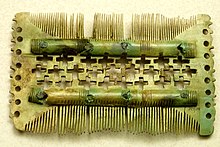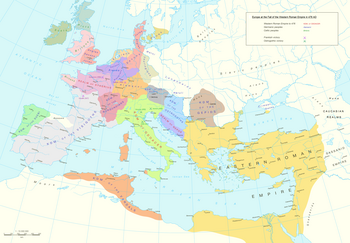Thuringii


The Thuringii, Toringi or Teuriochaimai
First appearances

The Thuringians do not appear in classical Roman texts under that name, but some have suggested that they were the remnants of the
The name of the Thuringians appears to be first mentioned in the veterinary treatise of Vegetius, written early in the fifth century.[5]
They appear in some lists of the peoples involved in
More clearly, correspondence is recorded with a kingdom of Thuringians by Procopius and
Political history

The Thuringii established an empire in the late fifth century. It reached its territorial peak in the first half of the sixth before it was conquered by the
After their conquest, the Thuringii were placed under Frankish dukes, but they rebelled and had regained their independence by the late seventh century under
By the time of Charles Martel and Saint Boniface, they were again subject to the Franks and ruled by Frankish dukes, with their seat at Würzburg in the south. Under Martel, the Thuringian dukes' authority was extended over a part of Austrasia and the Bavarian plateau. The valleys of the Lahn, Main, and Neckar rivers were included. The Naab formed the south-eastern border of Thuringia at the time. The Werra and Fulda valleys were within it also and it reached as far as the Saxon plain in the north. Its central location in Germania, beyond the Rhine, was the reason it became the point d'appui of Boniface's mission work.
The Thuringii had a separate identity as late as 785–786, when one of their leading men,
Ecclesiastical history
Christianity had reached the Thuringii in the fifth century, but their exposure to it was limited. Their real
In the 1020s,
Social history
The Thuringian nobility, which had an admixture of Frankish, Thuringian, and Saxon blood, was not as
Historiography
The history of the Thuringii is best known from the writings concerning their conquerors, the Franks.
The Thuringii make brief appearances in contemporary Italian sources when their activities affect the land south of the
Sources
- Reuter, Timothy. Germany in the Early Middle Ages 800–1056. New York: Longman, 1991.
- Thompson, James Westfall. Feudal Germany. 2 vol. New York: Frederick Ungar Publishing Co., 1928.
- Schutz, Herbert. The Germanic Realms in Pre-Carolingian Central Europe, 400–750. American University Studies, Series IX: History, Vol. 196. New York: Peter Lang, 2000.
See also
- List of Germanic peoples
- Barbarian invasions
- Turcilingi
Notes
- ISBN 9783110065138
- ISBN 9780191744457. Retrieved January 26, 2020.
Thuringians... A Germanic people in central Germania...
- ^ Schutz, 402.
- ^ H. B., Dewing (1962). Procopius. Cambridge, Massachusetts: Harvard University Press. p. 255.
- ^ Guy Halsall, Barbarian Migrations and the Roman West 376-568, p.39, citing B. Schmidt.
- ISBN 9780812239393. p.216
- ^ Halsall p.392
- ^ Schutz, 411.
- ^ Peters, Edward (2003). History of the Lombards: Translated by William Dudley Foulke. University of Pennsylvania Press.
{{cite book}}: CS1 maint: location missing publisher (link)
